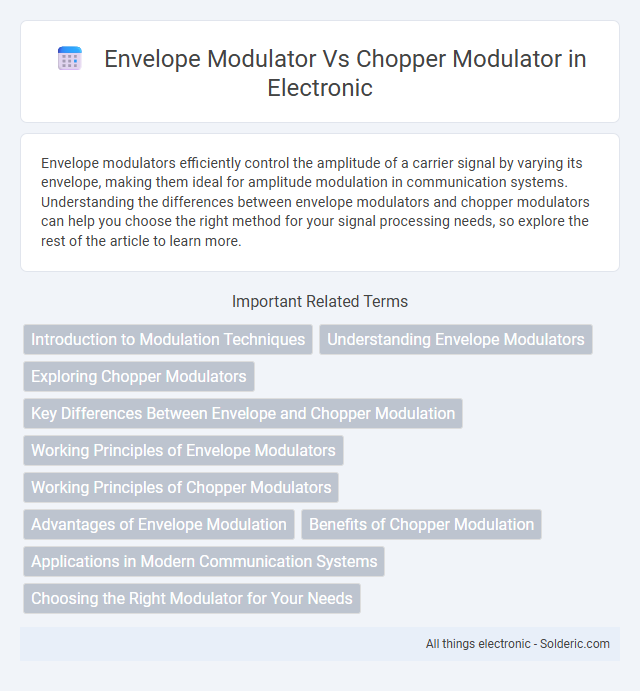Envelope modulators efficiently control the amplitude of a carrier signal by varying its envelope, making them ideal for amplitude modulation in communication systems. Understanding the differences between envelope modulators and chopper modulators can help you choose the right method for your signal processing needs, so explore the rest of the article to learn more.
Comparison Table
| Feature | Envelope Modulator | Chopper Modulator |
|---|---|---|
| Modulation Type | Analog AM modulation | Digital/pulse modulation |
| Working Principle | Varies carrier amplitude according to message signal envelope | Switches the carrier on/off to generate pulses matching message |
| Complexity | Simple circuitry | More complex switching circuits |
| Signal Distortion | Prone to envelope distortion and non-linearities | Less envelope distortion, better signal clarity |
| Efficiency | Lower power efficiency | Higher power efficiency due to switching operation |
| Applications | AM radio transmission | Pulse modulation, digital signal processing |
| Frequency Spectrum | Continuous spectrum around carrier frequency | Discrete pulses with sharper spectral characteristics |
Introduction to Modulation Techniques
Envelope modulators extract the amplitude envelope of a carrier signal to convey information, making them fundamental in amplitude modulation (AM) systems. Chopper modulators, on the other hand, rapidly switch the input signal on and off to produce a pulsed output, widely used in digital communication and signal processing. Your choice between these modulation techniques depends on the application requirements for bandwidth, signal integrity, and complexity.
Understanding Envelope Modulators
Envelope modulators extract the amplitude variations of a high-frequency carrier to control the output signal, essential in AM radio transmissions for preserving the message's integrity. Chopper modulators, on the other hand, rapidly switch the input signal on and off to generate a pulsed output, commonly used in power electronics for efficient voltage regulation. Your choice between envelope and chopper modulators depends on the application's need for signal fidelity versus switching efficiency.
Exploring Chopper Modulators
Chopper modulators provide precise control by rapidly switching the input signal on and off, offering efficient frequency translation in communication systems. Unlike envelope modulators, which vary the amplitude of the carrier wave, chopper modulators generate a modulated signal with reduced distortion and improved signal integrity. When exploring chopper modulators, you benefit from enhanced linearity and better noise performance, making them ideal for high-fidelity applications.
Key Differences Between Envelope and Chopper Modulation
Envelope modulators vary the amplitude of a carrier wave in direct proportion to the message signal, making them ideal for amplitude modulation (AM) applications. Chopper modulators, however, switch the carrier on and off at a rapid rate to create pulsed waveforms, commonly used in digital signal processing or power regulation. Your choice depends on whether you need smooth amplitude variation (envelope modulation) or discrete switching control (chopper modulation) for efficient signal transmission or power management.
Working Principles of Envelope Modulators
Envelope modulators work by varying the amplitude of a carrier signal in direct proportion to the instantaneous amplitude of the input message signal, preserving the waveform's shape for effective amplitude modulation. This technique emphasizes the envelope of the message signal, making it crucial in AM transmission systems where preserving signal integrity impacts clarity and range. Your choice of envelope modulator influences signal strength and fidelity in communication applications.
Working Principles of Chopper Modulators
Chopper modulators operate by rapidly switching the input signal on and off at a specific chopping frequency, effectively converting a low-frequency input into a high-frequency output for easier transmission. This switching action produces a pulsating signal that can be filtered and amplified, enabling efficient modulation of analog signals. Unlike envelope modulators that vary amplitude directly, chopper modulators rely on the controlled switching mechanism to encode the information onto the carrier wave.
Advantages of Envelope Modulation
Envelope modulators offer superior spectral efficiency by producing less harmonic distortion compared to chopper modulators, making them ideal for high-fidelity communication systems. Their simple circuit design ensures lower power consumption and easier implementation, which enhances overall system reliability. You benefit from improved signal quality and reduced interference, crucial for clear and stable transmissions.
Benefits of Chopper Modulation
Chopper modulation offers superior efficiency by reducing power loss during signal transmission, making it ideal for high-frequency applications. It provides better linearity and lower distortion compared to envelope modulators, enhancing signal fidelity and overall performance. Your communication system benefits from improved noise immunity and simpler circuit design, which contribute to reliable and cost-effective modulation solutions.
Applications in Modern Communication Systems
Envelope modulators are widely used in amplitude modulation (AM) for broadcasting signals over radio frequencies, offering efficient transmission for voice and music in commercial radio and television. Chopper modulators excel in digital communication systems where precise pulse generation and signal integrity are critical, such as in radar and telemetry applications. Your choice between these modulators depends on the need for either analog amplitude control or high-speed digital signal modulation in modern communication infrastructures.
Choosing the Right Modulator for Your Needs
Envelope modulators provide smooth amplitude variation ideal for audio and communication signals requiring minimal distortion, while chopper modulators offer precise switching control suited for digital and pulsed signal applications. Selecting the right modulator depends on factors like signal fidelity, switching speed, power efficiency, and complexity of the modulation scheme. Evaluating these parameters ensures optimal performance tailored to specific technical requirements and system constraints.
Envelope modulator vs chopper modulator Infographic

 solderic.com
solderic.com